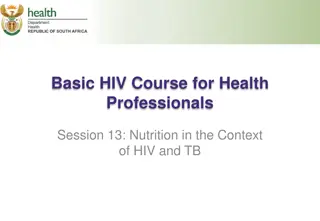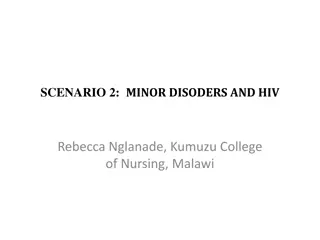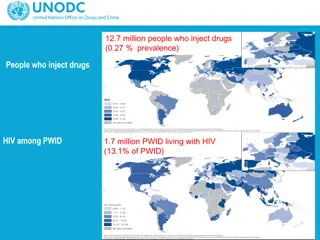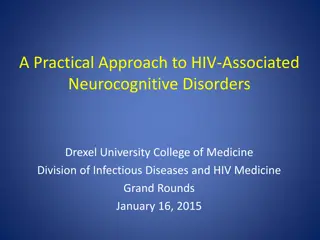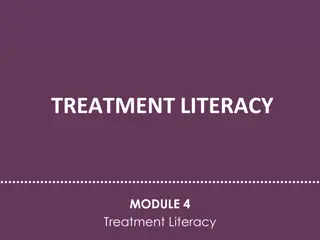Understanding the Impact of HIV on Nutrition
This training session focuses on the relationship between undernutrition and HIV, discussing how HIV/AIDS affects nutrition among People Living with HIV (PLHIV). It covers the benefits of good nutrition for PLHIV and provides recommendations for Nutrition Assessment, Counselling, and Support (NACS) for PLHIV. The session explores how HIV contributes to weight loss, muscle tissue loss, body fat loss, and deficiencies in minerals and vitamins. It also addresses HIV-associated wasting syndrome and its contributing factors.
Download Presentation

Please find below an Image/Link to download the presentation.
The content on the website is provided AS IS for your information and personal use only. It may not be sold, licensed, or shared on other websites without obtaining consent from the author. Download presentation by click this link. If you encounter any issues during the download, it is possible that the publisher has removed the file from their server.
E N D
Presentation Transcript
Integrating Nutrition Assessment, Counselling, and Support into Health Service Delivery Training Course for Facility-Based Health Providers Session 3.1 Interaction between HIV and Nutrition Integrating Nutrition Assessment, Counselling, and Support into Health Service Delivery 1
Session Objectives By the end of the session, participants will be able to: Explain the relationship between undernutrition and HIV Describe how HIV/AIDS affects nutrition among PLHIV Discuss the benefits of good nutrition for PLHIV Explain recommendations for NACS for PLHIV Integrating Nutrition Assessment, Counselling, and Support into Health Service Delivery 2
Group Brainstorm How does HIV affect nutritional status? Integrating Nutrition Assessment, Counselling, and Support into Health Service Delivery 3
The Cycle of Undernutrition and HIV/AIDS Integrating Nutrition Assessment, Counselling, and Support into Health Service Delivery 4
How HIV Affects Nutritional Status HIV contributes to weight loss, loss of muscle tissues and body fat, and mineral and vitamin deficiencies by: o Changing body metabolism o Leading to opportunistic infections/illness (TB), which can further worsen nutrition status o Causing HIV-associated wasting syndrome Integrating Nutrition Assessment, Counselling, and Support into Health Service Delivery 5
HIV-Associated Wasting Syndrome Contributing factors include: o Reduced energy intake coupled with increased nutrient requirements o Gastrointestinal tract disorders such as diarrhoea and malabsorption o Metabolic changes o HIV-associated infections Managed with ART for HIV infection and treatment of secondary infections Integrating Nutrition Assessment, Counselling, and Support into Health Service Delivery 6
Group Brainstorm What are the effects of undernutrition on HIV/AIDS? Integrating Nutrition Assessment, Counselling, and Support into Health Service Delivery 7
Effects of Undernutrition on HIV/AIDS Undernutrition (both vitamin/mineral deficiencies and inadequate food intake) speeds up disease progression through: o Increased HIV replication and viral load o Reduced immune functions and immune response o Increased susceptibility to secondary infections Integrating Nutrition Assessment, Counselling, and Support into Health Service Delivery 8
Effects of Undernutrition on HIV/AIDS Undernutrition also worsens HIV outcomes: Faster progression from HIV to AIDS Increased risk of mortality Increased risk of mother-to-child transmission of HIV Integrating Nutrition Assessment, Counselling, and Support into Health Service Delivery 9
Common Effects of Undernutrition and HIV Both undernutrition and HIV infection impair cell- mediated immunity. Signs include reduced: o CD4 T-lymphocytes o CD4/CD8 ratio o Serological response after immunization o Immune response to infection HIV and undernutrition also affecting the accuracy of results of Mantoux/PPD/tuberculin sensitivity test. Integrating Nutrition Assessment, Counselling, and Support into Health Service Delivery 10
Group Discussion What are the benefits of good nutrition among people living with HIV? Integrating Nutrition Assessment, Counselling, and Support into Health Service Delivery 11
Benefits of Good Nutrition for PLHIV Good nutrition helps PLHIV: Prevent malnutrition and wasting Fight opportunistic infections Achieve and maintain optimal body weight Build and maintain muscle mass Improve the effectiveness of medications Prolong good health Improve quality of life Integrating Nutrition Assessment, Counselling, and Support into Health Service Delivery 12
Nutritional Management of PLHIV Nutritional assessment, counselling, and support (NACS) for PLHIV should start early in course of HIV infection. Purpose of NACS for PLHIV o Improve nutritional status o Minimize loss of muscle mass o Promote/improve adherence to ART o Improve treatment efficacy and manage side effects o Slow disease progression o Improve quality of life Integrating Nutrition Assessment, Counselling, and Support into Health Service Delivery 13
Small Group Work: NACS for PLHIV (40 min) Break into three groups: o Nutrition assessment o Nutrition counselling o Nutrition support Develop recommendations for your topic o What nutrition assessments should be done for PLHIV? When/how frequently? o What are key nutrition counselling messages for PLHIV? o What types of support should be given to PLHIV? Present to plenary o Receive feedback, additional ideas from plenary Integrating Nutrition Assessment, Counselling, and Support into Health Service Delivery 14
Assessment Regular assessment should include o Anthropometric: height/weight, BMI, MUAC for pregnant/postpartum women o Biochemical: for detection of nutrient deficiencies (e.g., anaemia, micronutrients) o Clinical: symptoms that affect food intake, signs of clinical malnutrition, signs of anaemia o Dietary: types and amounts of foods being eaten, appetite, eating behaviours Integrating Nutrition Assessment, Counselling, and Support into Health Service Delivery 15
Assessment Living environment: cleanliness and sanitation, access to/use of safe water, food hygiene behaviors Lifestyle practices: smoking, alcohol, and drug use Integrating Nutrition Assessment, Counselling, and Support into Health Service Delivery 16
Counselling PLHIV should be counselled to: Consume more food and a wider variety of food than they normally do. o Diverse, energy- and nutrient-rich foods o Locally-available, culturally-appropriate o Fortified foods o Food that help meet micronutrient needs Integrating Nutrition Assessment, Counselling, and Support into Health Service Delivery 17
Counselling Increase food consumption o Eat smaller meals (and snacks) more frequently throughout the day, especially if appetite is a problem. o Asymptomatic adults need about one extra snack daily. o Symptomatic adults need about 2-3 extra snacks daily. o HIV-infected children should be monitored closely. If asymptomatic, need 10% more energy (about 1 small snack) If symptomatic, 20-30% more energy (about 2-3 small snacks) 50-100% more energy if losing weight (additional 1 or 2 meals) Amounts of extra food needed vary by age o Prepare favourite foods. Integrating Nutrition Assessment, Counselling, and Support into Health Service Delivery 18
Counselling Consume adequate protein from both animal and plant sources to build/maintain muscle mass and support immune system Integrating Nutrition Assessment, Counselling, and Support into Health Service Delivery 19
Counselling Consume fat in moderation (for PLHIV w/out fat malabsorption or diarrhoea). o Fats/oils rich sources of energy o May add flavour to food, increasing appetite o Aids absorption of fat-soluble nutrients o Same recommendation as for uninfected individuals: 20%-35% of total energy as fat Integrating Nutrition Assessment, Counselling, and Support into Health Service Delivery 20
Counselling Treat illness promptly. Practice good personal and food hygiene and sanitation. o Wash hands with soap and clean flowing water. o Treat water and store in covered container. o Ensure safe handling/disposing of faeces and garbage. o Ensure safe preparation and storage of food. Integrating Nutrition Assessment, Counselling, and Support into Health Service Delivery 21
Support Specialized food products for clinically malnourished PLHIV: ready-to-use therapeutic foods, therapeutic milks, fortified blended foods o Dense in energy, protein, and micronutrients o Safe and easy to use Multiple micronutrient supplements Referrals to livelihood, social development, and other complementary programs Integrating Nutrition Assessment, Counselling, and Support into Health Service Delivery 22
Special Considerations for Pregnant Women with HIV Nutritional needs increased by both HIV and pregnancy o Must eat at least one additional meal/day Weight gain should be monitored regularly Option B+: ARV treatment, regardless of CD4 count (life long) Integrating Nutrition Assessment, Counselling, and Support into Health Service Delivery 23
Special Considerations for HIV-Exposed Newborns Option B+: prevent transmission of HIV and ensure health/survival of child o 6 weeks of ARV treatment, according to national guidelines o Testing at 6 weeks o Exclusive breastfeeding for 6 months o Continued breastfeeding for 12 months 24 months if child is HIV-positive Integrating Nutrition Assessment, Counselling, and Support into Health Service Delivery 24
Special Considerations for Children with HIV Especially vulnerable to malnutrition: o High nutritional needs for growth and fighting HIV o Dependent on others for care and feeding Require careful monitoring to identify and address health and nutrition issues Nutrition care plan, based on child s needs, family s economic circumstances, care practices Supplements may be needed at times Integrating Nutrition Assessment, Counselling, and Support into Health Service Delivery 25
Summary of Key Points There is a synergistic and cyclical relationship between HIV and undernutrition. HIV affects nutrition by increasing nutrient requirements, decreasing food consumption, impairing nutrient absorption, and causing metabolic changes that lead to weight loss and vitamin and mineral deficiencies. Poor nutritional status is associated with faster HIV disease progression and death. Improving and maintaining good nutrition may prolong health and delay HIV disease progression. Nutritional assessment and counselling should start early in the course of the HIV infection, even before other disease symptoms are observed. Integrating Nutrition Assessment, Counselling, and Support into Health Service Delivery 26
Thank you! Questions, additions, or clarifications? Integrating Nutrition Assessment, Counselling, and Support into Health Service Delivery 27





